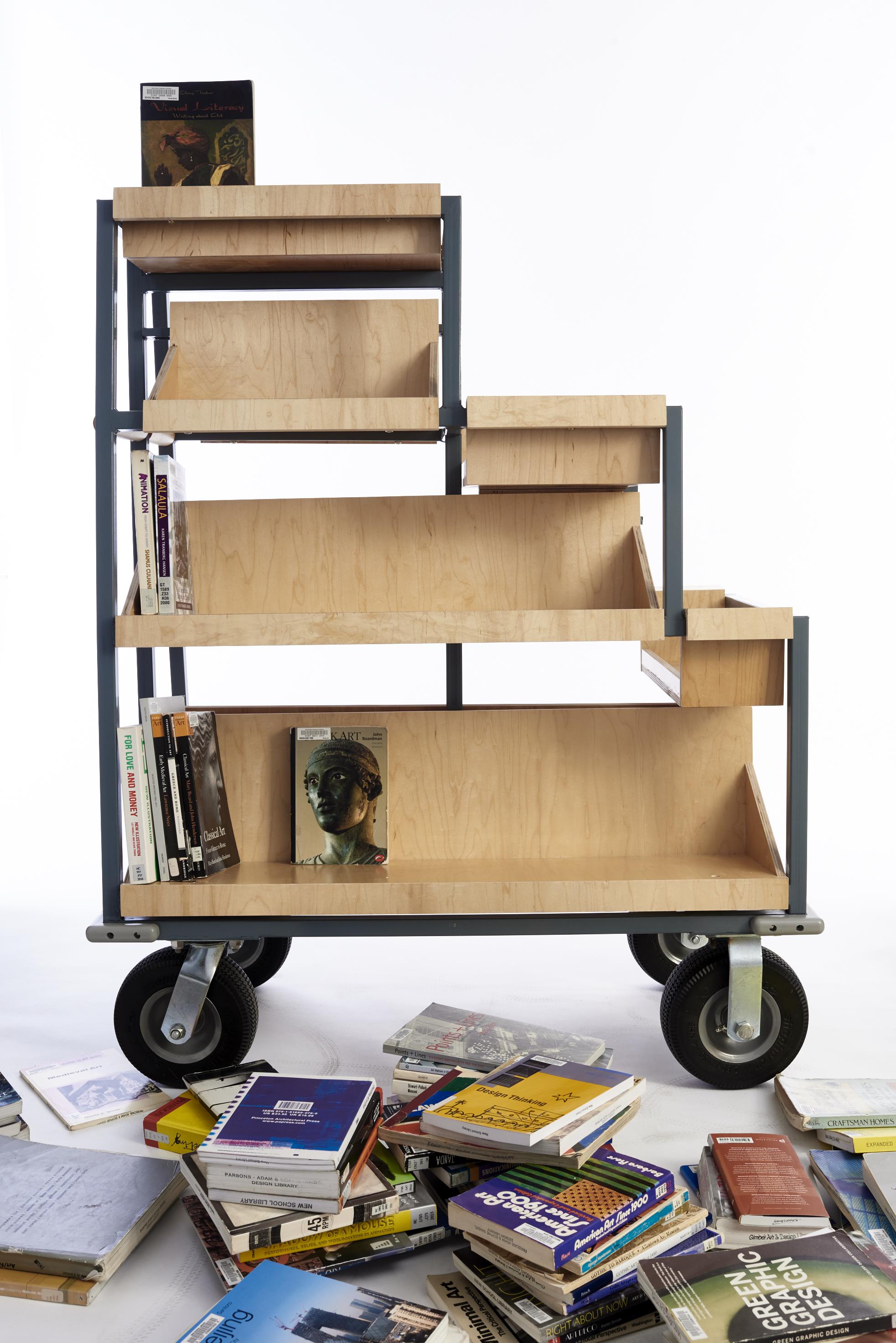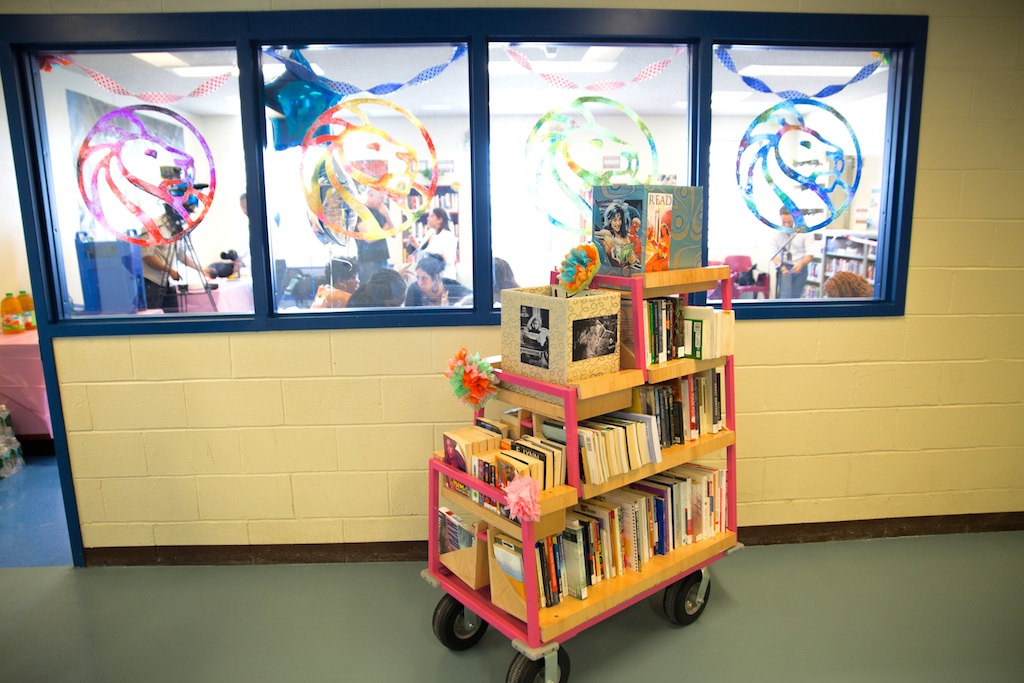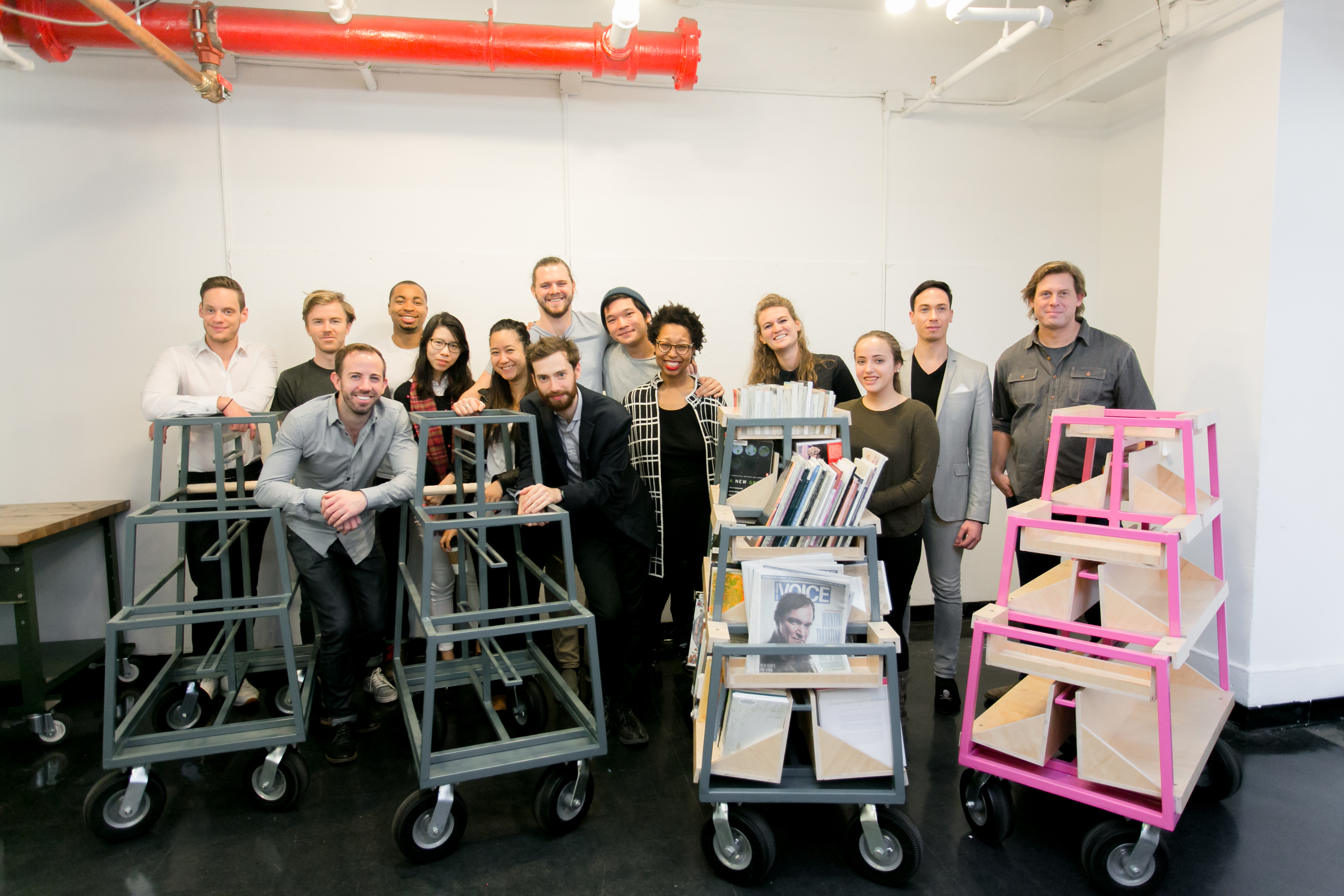Dear Library Patron,
Joel Stoehr

I’m pink, or grey, shiny paint over steel. I’m tall, but I get narrow at the top. I’m long, but wide at the bottom. I’ve got fancy plywood shelves that are slightly fragile, and a little too complicated to construct. I combine wood, rubber and steel. I wish to be practical, to do my job and do it well, so that I make others’ lives easier, but I also want you to think that I am beautiful and unexpected.
I am the product of a team, a group of individuals who agreed to work together to solve a problem. It took compromise to make me. Thirteen design students along with one assistant professor and a team of librarians contributed to transforming me from an idea into a reality. It also took time—a lot of time. Time to source and order materials. Time to cut and weld the steel pieces. Time to get the steel frames painted. Time to cut and build the plywood shelves. Time to add the casters and the bumpers so that I don’t damage corners. Time that many people devoted toward turning me from plans and ideas into functioning furniture. Within this time there is usually a moment of epiphany when one realizes that a drawing on the computer is very much an abstract idea compared to a perfectly joined and square plywood edge, or a ninety-degree weld. I like to think I taught a thing or two to my designers. I also strive to be necessary, useful, and desirable.
I am the product of a team, a group of individuals who agreed to work together to solve a problem. It took compromise to make me. Thirteen design students along with one assistant professor and a team of librarians contributed to transforming me from an idea into a reality. It also took time—a lot of time. Time to source and order materials. Time to cut and weld the steel pieces. Time to get the steel frames painted. Time to cut and build the plywood shelves. Time to add the casters and the bumpers so that I don’t damage corners. Time that many people devoted toward turning me from plans and ideas into functioning furniture. Within this time there is usually a moment of epiphany when one realizes that a drawing on the computer is very much an abstract idea compared to a perfectly joined and square plywood edge, or a ninety-degree weld. I like to think I taught a thing or two to my designers. I also strive to be necessary, useful, and desirable.

The New York Public Library’s mobile book cart at the Rose M. Singer Center, a women’s facility on Rikers Island, New York
It took the input of a team of librarians to explain to the designers what they needed in a book cart. Communicating what worked and what did not work, how library service is conducted, what facilities are visited. Negotiating the entrance and exit process, what doorways, thresholds, gates, and elevators I had to enter and exit. How I rolled down a hallway. Where I could be parked while in service.
The librarians told the designers what titles I needed to carry. How many books, magazines, and newspapers they wanted to be able to offer. They talked about how the users of the cart browse these titles. The design team took that experience into consideration when they decided how and where I would carry reading material.
I roll. I am heavy, but also stable. If you need to, you can lean against me to help you browse. I like to think that my job is to carry an escape, or a distraction from the banal. That’s why I am shaped and colored the way I am. I strive to stand out from my surroundings. I don’t want to be drab or appear to be worn out.
I am a small change to the ordinary in a large system that does not usually welcome change. My predecessors did the same job I am doing now, but I like to think I do it better. They were lunch carts, plastic carts, anything that rolled and could carry books. I like to think that I offer more. Ultimately, I am a piece of furniture, but in doing my job differently than those that came before me, I hope to relieve you from the routine of the everyday.
Sincerely,
Your Book Cart
The librarians told the designers what titles I needed to carry. How many books, magazines, and newspapers they wanted to be able to offer. They talked about how the users of the cart browse these titles. The design team took that experience into consideration when they decided how and where I would carry reading material.
I roll. I am heavy, but also stable. If you need to, you can lean against me to help you browse. I like to think that my job is to carry an escape, or a distraction from the banal. That’s why I am shaped and colored the way I am. I strive to stand out from my surroundings. I don’t want to be drab or appear to be worn out.
I am a small change to the ordinary in a large system that does not usually welcome change. My predecessors did the same job I am doing now, but I like to think I do it better. They were lunch carts, plastic carts, anything that rolled and could carry books. I like to think that I offer more. Ultimately, I am a piece of furniture, but in doing my job differently than those that came before me, I hope to relieve you from the routine of the everyday.
Sincerely,
Your Book Cart
 Students at Parsons School of Design in collaboration with New York Public Library designed book carts for NYPL's Correctional Services Program. (Photo/Phillip Van Nostrand)
Students at Parsons School of Design in collaboration with New York Public Library designed book carts for NYPL's Correctional Services Program. (Photo/Phillip Van Nostrand)P.S.
Thanks to Charles Andrews, Filip Forsberg, Colin Fuda, Kenneth Garnett, Christian Neuner, Maria Rico, Lisanne Rissik, Benjamin Schuetz, Tkako Taniguchi, Michael Thai, Zin Thet, Misha Volf, and Jasmine Wright
– Design and Fabrication Team.
Thanks to Joel Stoehr, Assistant Professor of Design, School of Constructed Environments, Parsons School of Design.
Thanks to Sarah Ball, Emily Jacobson, Louise Stamp, and Yanela Ortega
– New York Public Library.
Thanks to Charles Andrews, Filip Forsberg, Colin Fuda, Kenneth Garnett, Christian Neuner, Maria Rico, Lisanne Rissik, Benjamin Schuetz, Tkako Taniguchi, Michael Thai, Zin Thet, Misha Volf, and Jasmine Wright
– Design and Fabrication Team.
Thanks to Joel Stoehr, Assistant Professor of Design, School of Constructed Environments, Parsons School of Design.
Thanks to Sarah Ball, Emily Jacobson, Louise Stamp, and Yanela Ortega
– New York Public Library.